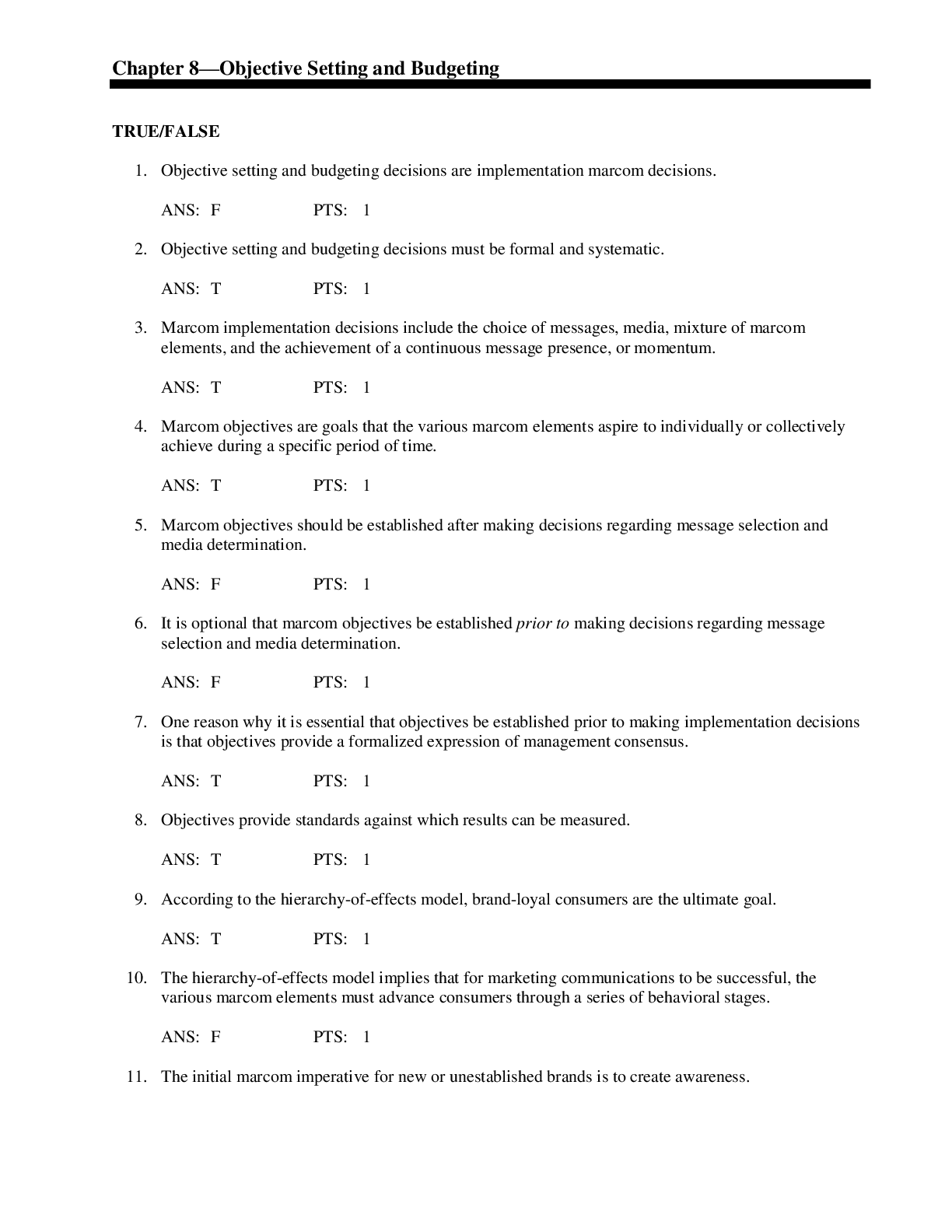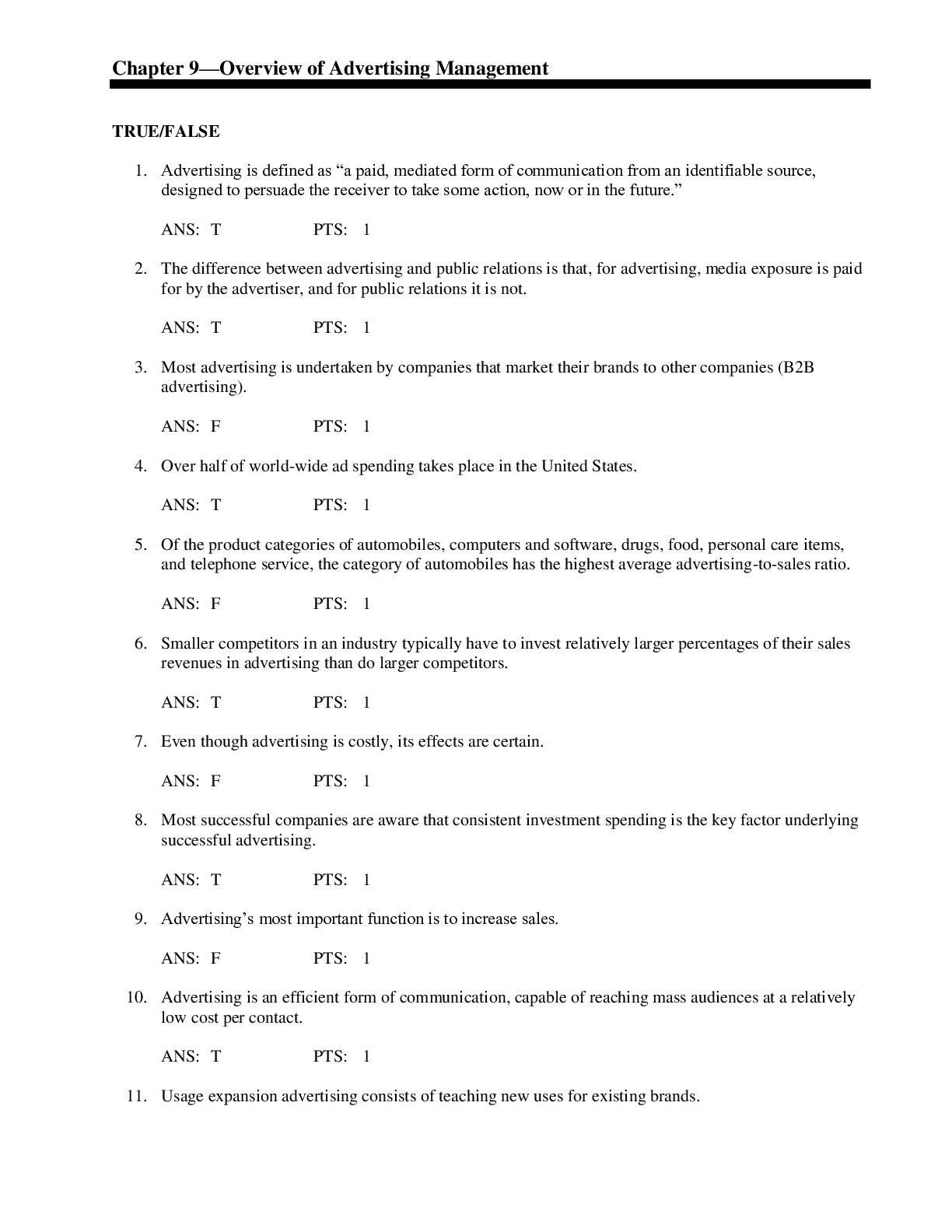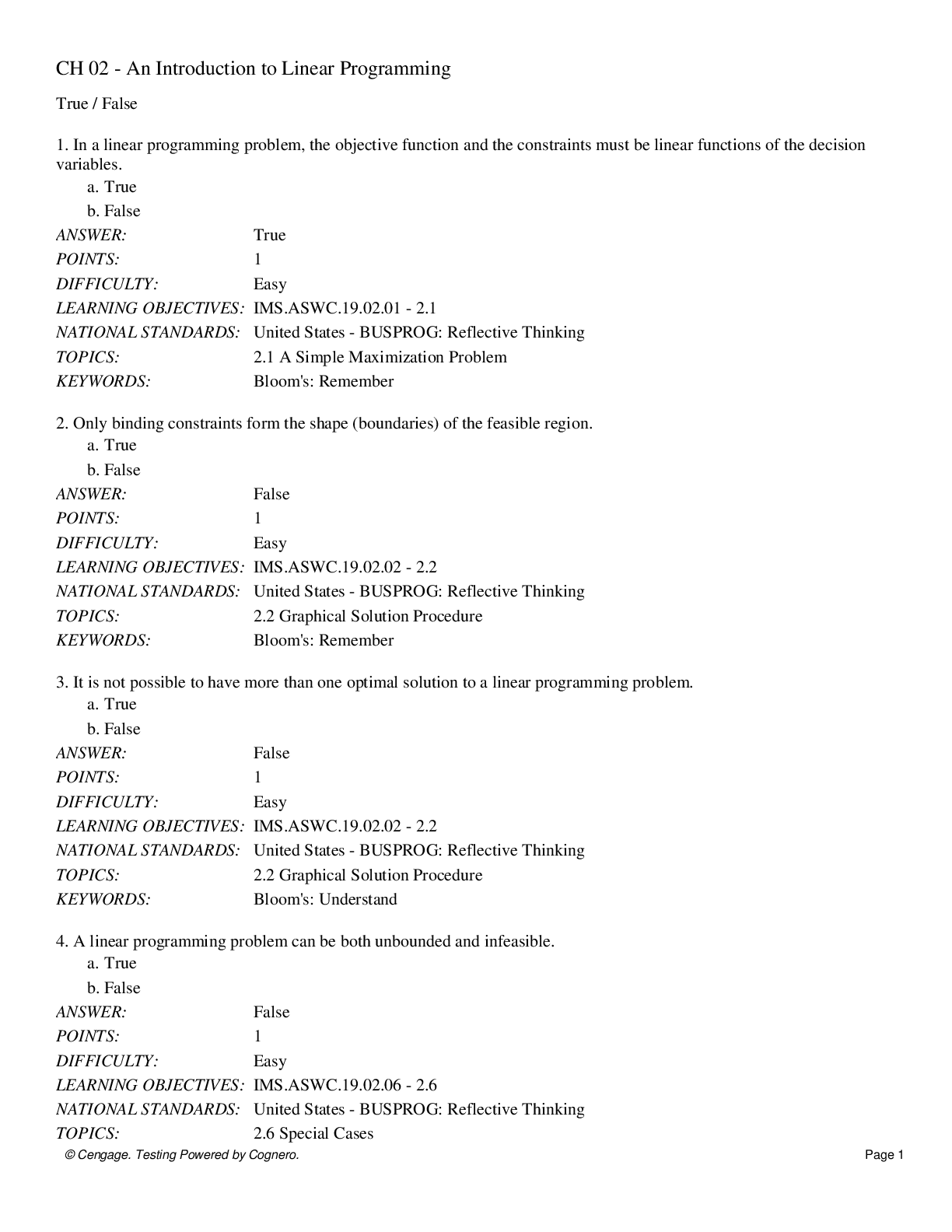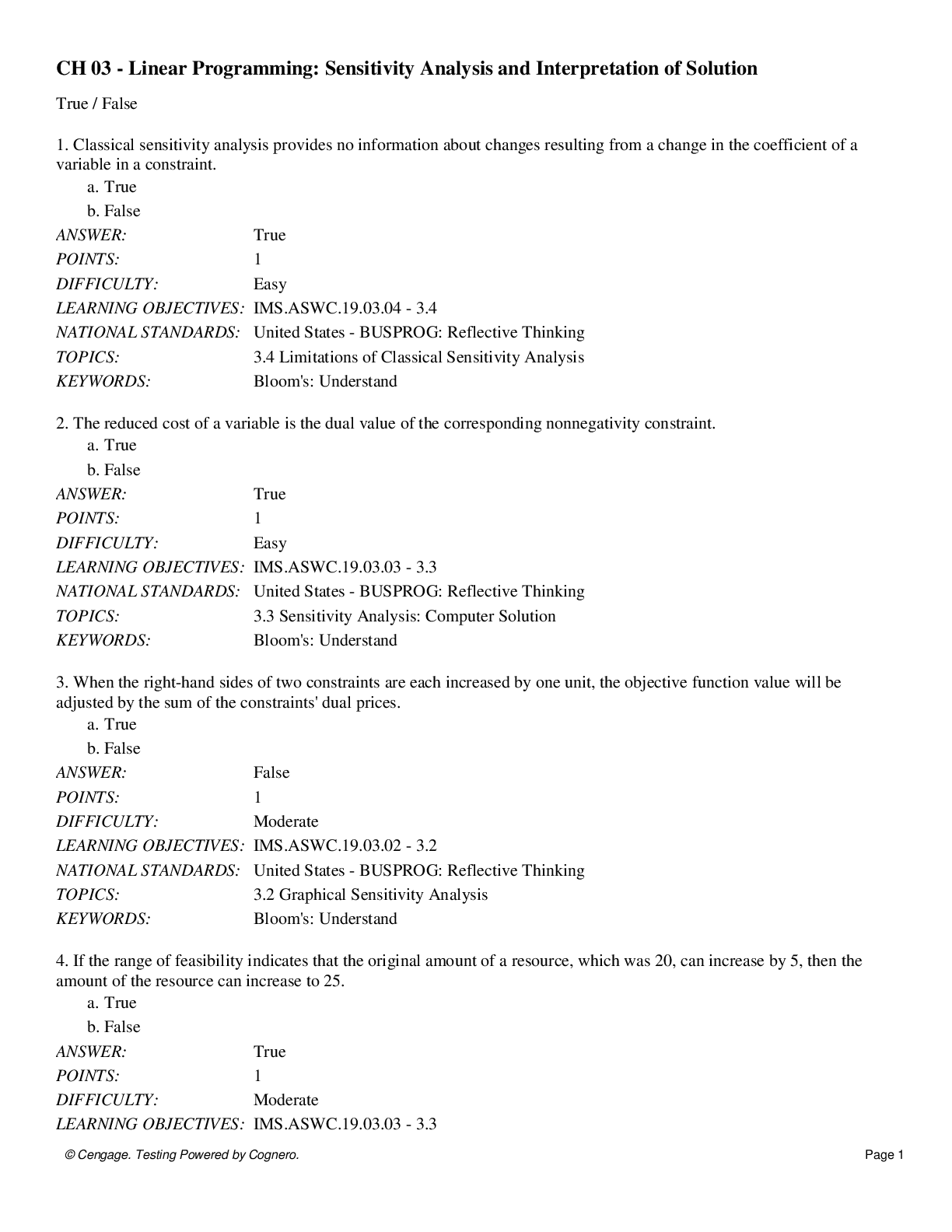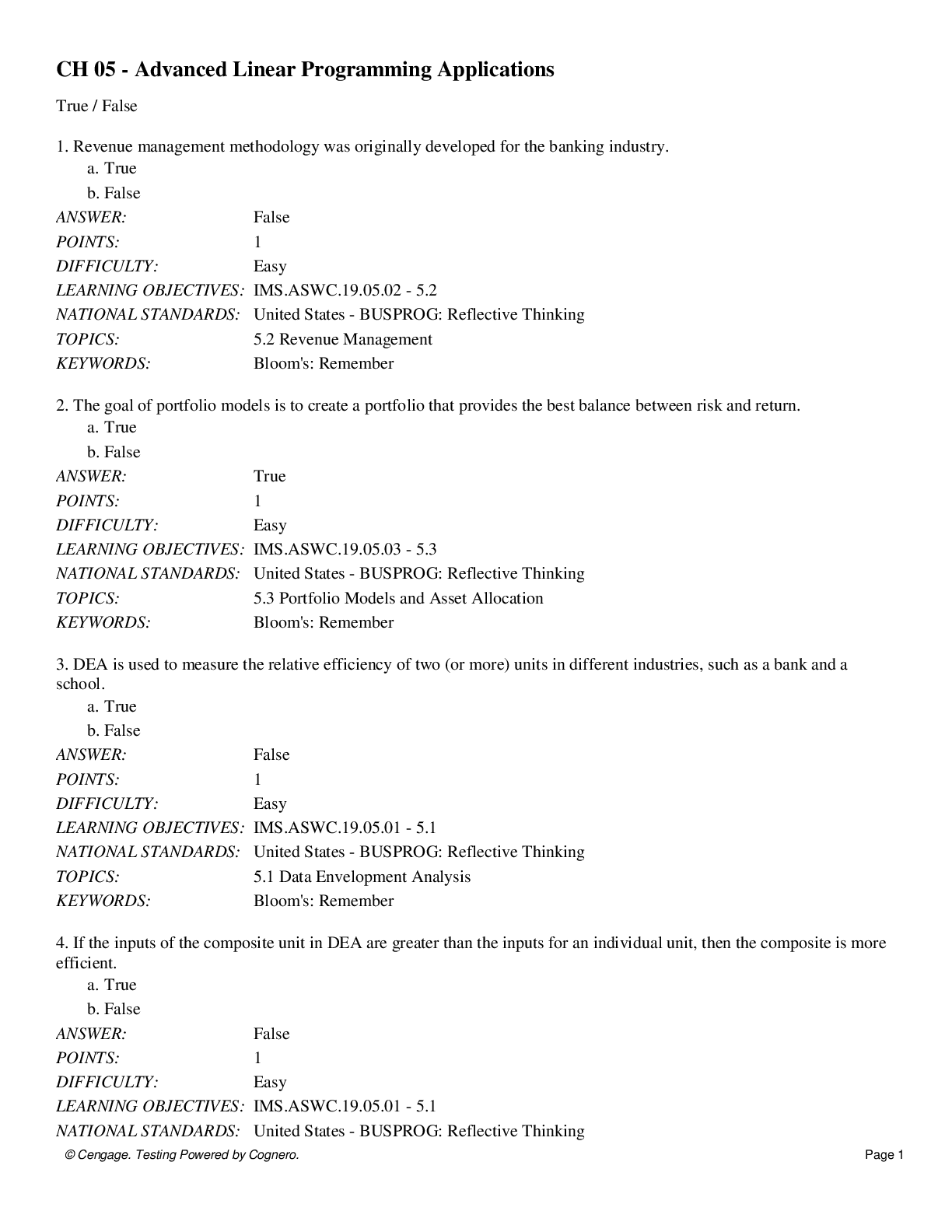Pathophysiology > QUESTIONS & ANSWERS > Neurosurgery Practice Questions and Answers (601-700) (All)
Neurosurgery Practice Questions and Answers (601-700)
Document Content and Description Below
601. Relative afferent pupillary defects are seen in the following disorders EXCEPT: A. Macular degeneration B. Optic neuritis C. Papilledema D. Metabolic optic neuropathy E. Retinal lesion 602.... Hypoxemia due to a 50% shunt is most likely to be improved by which of the following measures? A. Decreasing the positive end expiratory pressure to 0 cm H2O B. Hyperventilation C. Improving mixed venous oxygen contents D. Oxygen supplementation E. None of the above 603. The half-life of platelets used for transfusion is A. 96 hours. B. 72 hours. C. 48 hours. D. 24 hours. E. 12 hours. 604. Which phase of blood coagulation is the most time consuming? A. Conversion of prothrombin to thrombin B. Activation of contact factors C. Generation of thromboplastin D. Release of phospholipids from platelets E. Conversion of fibrinogen to fibrin Match the appropriate scan with the these statements: A. Image 1 B. Image 2 C. Images 1 and 2 D. None of the above 605. Caused by arrested development 606. Acquired after dural thrombosis 607. Associated with blue rubber nevus syndrome Match the associated ocular finding with the correct pathological state: A. Ocular bobbing B. Jerk nystagmus C. See-saw nystagmus D. Downbeat nystagmus E. None of the above 608. Foramen magnum compression 609. Craniopharyngioma 610. Germinoma 611. Pentobarbital infusion 612. Pontine glioma Match the cerebellar cell type with the appropriate description: A. Granule cell B. Golgi cell C. Purkinje cell D. Basket cell E. Stellate cell 613. Forms the glomerulus together with the granule cell 614. Excitatory neurotransmitter 615. End in a rete of terminals around the cell bodies of the Purkinje cell 616. Synapse with the interposed nuclei 617. Which of the following is the earliest sign of cyanide poisoning? A. Blurred vision B. Diaphoresis C. Apnea D. Hallucinations E. Sneezing 618. Which of the following minerals is important in wound healing? A. Manganese B. Zinc C. Iron D. Copper E. All of the above 619. The mechanism of action of aminoglycosides is best described by A. inhibition of DNA synthesis. B. cell membrane destruction. C. cell wall damage. D. inhibition of protein synthesis. E. None of the above 620. Antimicrobial agents causing neuromuscular blockade include all of the following EXCEPT: A. Streptomycin B. Kanamycin C. Neomycin D. Polymyxin E. Gentamicin 621. Given the aneurysm exposed by a far lateral approach (cerebellum retracted) (see intraoperative picture), which statement is true? A. The Allcock test is useful. B. External ventricular drainage following subarachnoid hemorrhage from this type of aneurysm is an accepted temporizing treatment. C. Proximal ligation is the preferred treatment. D. Vasospasm in this area is unlikely to cause respiratory compromise. E. A lumbar drain is contraindicated in this case. 622. In this tumor resection case (see intraoperative picture), which of these statements is FALSE? A. The dura needs to be opened at either end well above the lesion. B. Dilated veins are more likely to be encountered at the rostral end of the mass. C. Myelotomy is to be done as close to the midline as possible. D. Intracapsular decompression of the tumor is necessary to avoid any traction. E. C-arm guidance for localization may be helpful. 623. Accumulations seen in metachromatic leukodystrophy are A. sulfatides. B. galactocerebroside. C. ganglioside. D. long-chain fatty acids. E. None of the above 624. The T-reflex represents A. flexor response as seen in decerebrate rigidity. B. crossed extensor reflex. C. monosynaptic stretch reflex. D. supramaximal stimulation of a mixed motor-sensory nerve. E. All of the above 625. The trochlear nerve arises from the brainstem at the level of the A. lower pons. B. upper pons. C. lower midbrain. D. upper midbrain. E. medulla. 626. A 57-year-old man with a known history of lung cancer presents with generalized muscle weakness. The most likely associated finding is A. opsoclonus. B. increased glutamic acid decarboxylase. C. anti–Purkinje cell antibodies. D. presynaptic acetylcholine receptor disorder. E. multiple sclerosis. 627. To produce 1 mEq/L rise in serum potassium, the total body potassium stores need to increase by what quantity? A. 50 mEq B. 150 mEq C. 350 mEq D. 500 mEq E. 1000 mEq 628. If the C6 nerve root is severed, all of the following may be affected EXCEPT: A. Lateral cord B. Ulnar nerve C. Musculocutaneous nerve D. Median nerve E. Lower subscapular nerve Match each plexus with its innervation: A. Brachial plexus B. Cervical plexus C. Lumbar plexus D. Cervical and brachial plexuses E. None of the above 629. Inferior belly of the omohyoid 630. C5 nerve root 631. Obturator nerve 632. Levator scapulae 633. External urethral sphincter 634. Sternocleidomastoid 635. Which of the following is a characteristic of narcolepsy? A. Hallucinations while sleeping B. Convulsions while sleeping C. Daytime hyperalertness D. NREM onset of sleep E. Gelastic seizures For the following items, match the vitamin excess or deficiency and the clinical disorder: A. Thiamine B. B6 C. Cobalamine D. Niacin E. Vitamin A 636. Pseudotumor cerebri 637. Beriberi 638. Increased serum homocysteine 639. Lower extremities paresthesias Match the effect with the pharmacological agent: A. Type A GABA agonist B. Type B GABA agonist C. GABA antagonist D. No effect on GABA receptors 640. Barbiturates 641. Picrotoxin 642. Baclofen 643. Bicuculline 644. The two aneurysms seen in this intraoperative picture are A. anterior communicating and superior hypophyseal. B. basilar and anterior communicating. C. PICA and superior hypophyseal. D. PICA and basilar. E. basilar and posterior communicating. 645. Transcallosal approach for tumor resection shows this lesion (see intraoperative picture; the pertinent MRI is also shown). Which of the following statements is FALSE? A. A common presenting sign is papilledema. B. It arises from the diencephalic recess of the postvellar arch. C. Risk of sudden death is attributable to CSF dynamics or disturbances in hypothalamic-related cardiovascular control. D. Lumbar puncture is part of the initial workup. E. The patient may require a shunt postoperatively. 646. All of the following are associated with torsades de pointes EXCEPT: A. Phasic changes of amplitude and polarity of ventricular complexes B. Hypokalemia C. Hypomagnesemia D. Narrowed QT intervals E. May be predisposed by erythromycin 647. Which of the following enables one to distinguish early acute respiratory distress syndrome (ARDS) from early cardiogenic pulmonary edema? A. In early ARDS, the hypoxemia is more pronounced and the chest X-ray abnormalities are more evident. B. In early ARDS, the hypoxemia is less pronounced and the chest X-ray abnormalities are more evident. C. In early ARDS, the hypoxemia is more pronounced and the chest X-ray abnormalities are less evident. D. In early ARDS, the hypoxemia is less pronounced and the chest X-ray abnormalities are less evident. E. None of the above 648. All of the following are recommended therapeutic measures for diabetic ketoacidosis EXCEPT: A. Insulin B. Alkali therapy C. Potassium D. Crystalloids E. Phosphate 649. A 54-year-old man who is a heavy smoker presents with balance problems and the MRI scan and pathology slide from surgery shown here. The most likely diagnosis is A. metastasis. B. hemangioblastoma. C. glioma. D. central nervous system (CNS) lymphoma. E. pilocytic astrocytoma. 650. A 64-year-old man was admitted with mental status changes and a temperature of 103.4°F. Spinal fluid was obtained and showed 118 WBC, 49 RBC, 102 protein, and 79 glucose. The patient had an MRI scan, shown here. The most likely diagnosis is A. glioblastoma multiforme resection. B. radiation therapy. C. trauma. D. encephalitis. E. cerebral atrophy. 651. After a motorcycle accident, a patient is able to dorsiflex and invert his foot but is unable to evert his foot. The most likely nerve lesioned is the A. deep peroneal nerve. B. superficial peroneal nerve. C. common peroneal nerve. D. sciatic nerve. E. tibial nerve. 652. The brachial plexus structure just distal to the division is A. the trunk. B. the branch. C. the cord. D. the root. E. None of the above 653. This intraoperative picture shows a middle cerebral artery bifurcation aneurysm. What is the proper order of steps to ensure safe clipping of this aneurysm? A. Definitive clipping, temporary clipping, fissure splitting, dissection of M2 branch from dome B. Dissection of M2 branch from dome, fissure splitting, temporary clipping, definitive clipping C. Fissure splitting, temporary clipping, dissection of M2 branch from dome, definitive clipping D. Temporary clipping, fissure splitting, dissection of M2 branch from dome, definitive clipping E. Fissure splitting, dissection of M2 branch from dome, temporary clipping, definitive clipping 654. Molecular genetic alterations in glioma not part of a specific syndrome include all of the following EXCEPT: A. Overexpression of CDK4 B. Deletion of p53 C. Mutation of retinoblastoma D. Amplification of K-ras E. Overexpression of CDK6 655. Oligodendrogliomas exhibit loss of chromosomal regions on all the following EXCEPT: A. 1p B. 7 C. 9p D. 19q E. 22 656. All the following statements are true about the sympathetic nervous system EXCEPT: A. Stellate ganglionectomy is used in the treatment of long QT syndrome. B. Anhydrosis occurs with ganglionectomy. C. Each intercostal nerve is connected to the sympathetic trunk by at least one white ramus and two gray rami. D. The inferior hypogastric plexus lies in front of the promontory of the sacrum between the two common iliac arteries and is sometimes called the presacral nerve. E. Sympathetically conveyed stimulus to the sweat glands is transmitted by acetylcholine. Match the following limbic structures with the comments: A. Cingulate gyrus B. Hippocampus C. Amygdala D. Mammillary bodies E. Anterior nucleus of the thalamus 657. Not part of the Papez circuit 658. Receives inputs from the nucleus of the solitary tract 659. Receives inputs from the medial septal nucleus 660. Which of the following has the highest incidence of associated platelet disorders? A. Amyotrophic lateral sclerosis (ALS) B. Huntington’s disease C. Acute respiratory distress syndrome D. AIDS E. Multiple sclerosis 661. Which of the following is NOT associated with the finding on this scan? A. Congestive heart failure B. Pulmonary hypertension C. Renal failure D. Microcephaly E. Subarachnoid hemorrhage 662. All the following are associated with the finding on this MRI scan EXCEPT: A. The most common location is cervicothoracic. B. The presence of a malignancy is a predisposing condition. C. There is increased incidence with epidural anesthesia. D. The incidence is 1:10,000 in the United States. E. There is increased incidence with drug abuse. 663. The leading cause of magnesium deficiency is A. antibiotic therapy. B. diuretics. C. secretory diarrhea. D. diabetes mellitus. E. dilantin therapy. Match the appropriate ganglion with the nerve: A. Jugular B. Nodose C. Pterygopalatine D. Ciliary E. Superior cervical 664. Facial nerve 665. Oculomotor nerve 666. Arnold’s nerve 667. Deep petrosal nerve 668. All of the following may be used to differentiate between a lesion of the glossopharyngeal nerve and a lesion of the facial nerve EXCEPT: A. Loss of sensation to the outer ear B. Loss of taste on the tongue surface C. Loss of salivatory secretion from a gland D. Weakness of the pharynx E. Strength of facial muscles 669. The inotropic drug of choice for acute management of systolic heart failure is A. dopamine. B. dobutamine. C. neosinephrine. D. epinephrine. E. isoproterenol. 670. The toxicity of nitroprusside in the setting of decreased renal blood flow is mediated by A. cyanide. B. thiocyanate. C. nitric oxide. D. thiosulfate. E. vitamin B12. Match the lesions shown here with the correct disease: A. Lesion 1 B. Lesion 2 C. Lesions 1 and 2 D. None of the above 671. Eosinophilic granuloma 672. Langerhans cell histiocytosis 673. Paget’s disease 674. Albright’s syndrome 675. Epidermoid 676. The most common cause of admission of HIV-infected patients to the intensive care unit is A.Pneumocystis carinii pneumonia. B. cytomegalovirus infections. C. toxoplasmosis. D. AIDS encephalitis. E. hydrocephalus. 677. An isolated exposure of broken skin or mucous membranes to HIV-infected blood carries a risk of transmission of A. 9%. B. 0.9%. C. 0.09%. D. 0.009%. E. 0.0009%. 678. Differential diagnosis of the lesion shown here includes the listed choices EXCEPT: A. Chordoma B. Epidermoid C. Basilar tip aneurysm D. Arachnoid cyst E. Low-grade glioma Match the appropriate organelle with its function: A. Golgi organelle B. Endoplasmic reticulum C. Both A and B D. None of the above 679. Functional ribosomes occur on the outside of its membrane but not on the inside. 680. Phosphorylation of oligosaccharides 681. Important in drug detoxification 682. Glycogen formation and breakdown 683. Lamellar or tube-like membranous system 684. Neuromelanin has the following characteristics EXCEPT: A. Accumulates in neurons of the substantia nigra B. Found in the locus ceruleus C. Made by tyrosinase D. Is a cathecholamine waste product E. Chelates metal ions such as aluminum and iron 685. Amygdala afferents include all the following EXCEPT: A. Nucleus accumbens B. Pyriform cortex C. Solitary tract nucleus D. Locus ceruleus E. Prefrontal cortex 686. All the following are complications of total parenteral nutrition EXCEPT: A. Hypercapnia B. Acalculous cholecystitis C. Impaired oxygenation D. Calculous cholecystitis E. Increased incidence of infection 687. Which of the following findings is most closely associated with the lesion on this scan? A. May have elevated carcinoembryonic antigen (CEA) levels B. Associated with Schiller–Duval bodies C. Derived from extraembryonic tissue D. Ingestion of food with fecal contamination E. Multiple sclerosis 688. Which of the following is this scan finding associated with? A. Anti-Yo antibodies B. Anti-Hu antibodies C. Anti-Ri antibodies D. Antibodies to presynaptic voltage-gated receptors E. None of the above 689. Match the finding on this myelin-stained section with the most likely associated presentation: A. 40-year-old man with chronic encephalitis and Argyll Robertson pupils B. 15-year-old hyperglycemic with severe lower extremity weakness C. 55-year-old man with spastic gait, weakness, and fasciculation in all extremities D. 4-year-old boy with bilateral symmetric proximal limb weakness E. 60-year-old female with spondylolisthesis at L5–S1 Match the following disorders with the acid–base abnormality: A. Respiratory acidosis B. Respiratory alkalosis C. Both D. Neither 690. Pulmonary embolism 691. Meningitis 692. Liver cirrhosis 693. Aminoglycosides 694. All of the following statements are correct regarding this diffusion tractography scan EXCEPT: A. Water diffusion is hindered anteriorly by the presence of a large tumor. B. Connections between frontal and occipital lobe are impaired on the right side. C. There are intersecting white matter tracts between the splenium and the fronto-occipital tracts. D. Tractography gives information about the direction of flow. E. Bundles of axons provide a barrier to perpendicular diffusion and a path for parallel diffusion along the orientation of the fibers. 695. Which of the following is true regarding the finding on this MRI scan? A. It is associated with dermal sinus tract. B. It secretes histamine. C. On histopathology, one may see densely packed elongated spindle cells in interlocking fascicles with a tendency toward palisading. D. All of the above are true. E. None of the above are true. 696. All of the following findings may be associated with this MRI scan EXCEPT: A. Abnormality in protein merlin B. Posterior capsular lens opacities C. Intertriginous freckling D. Pigmented area of skin with excess hair E. May be associated with an autosomal disorder located on chromosome 22 697. Etiologies of distal renal tubular acidosis include all of the following EXCEPT: A. Amphotericin B B. Lithium C. Toluene D. Carbonic anhydrase inhibitors E. Cyclamate 698. Which of the following is NOT a valid therapeutic measure in patients with Addisonian crisis? A. Hydrocortisone sodium succinate (Solucortef) for glucocorticoid emergencies B. Fludrocortisone (Florinef) for mineralocorticoid emergencies C. Methylprednisolone (Solumedrol) for glucocorticoid emergencies D. Cortisone acetate for glucocorticoid emergencies E. Intravenous fluids 699. Therapeutic measures for syndrome of inappropriate antidiuretic hormone secretion include A. furosemide. B. phenytoin. C. lithium. D. All of the above E. None of the above 700. Which compatible plasma types can be given to a patient with blood type B? A. B and O plasma types B. B and AB plasma types C. B plasma type only D. All of the above E. None of the above [Show More]
Last updated: 1 year ago
Preview 1 out of 34 pages
Instant download
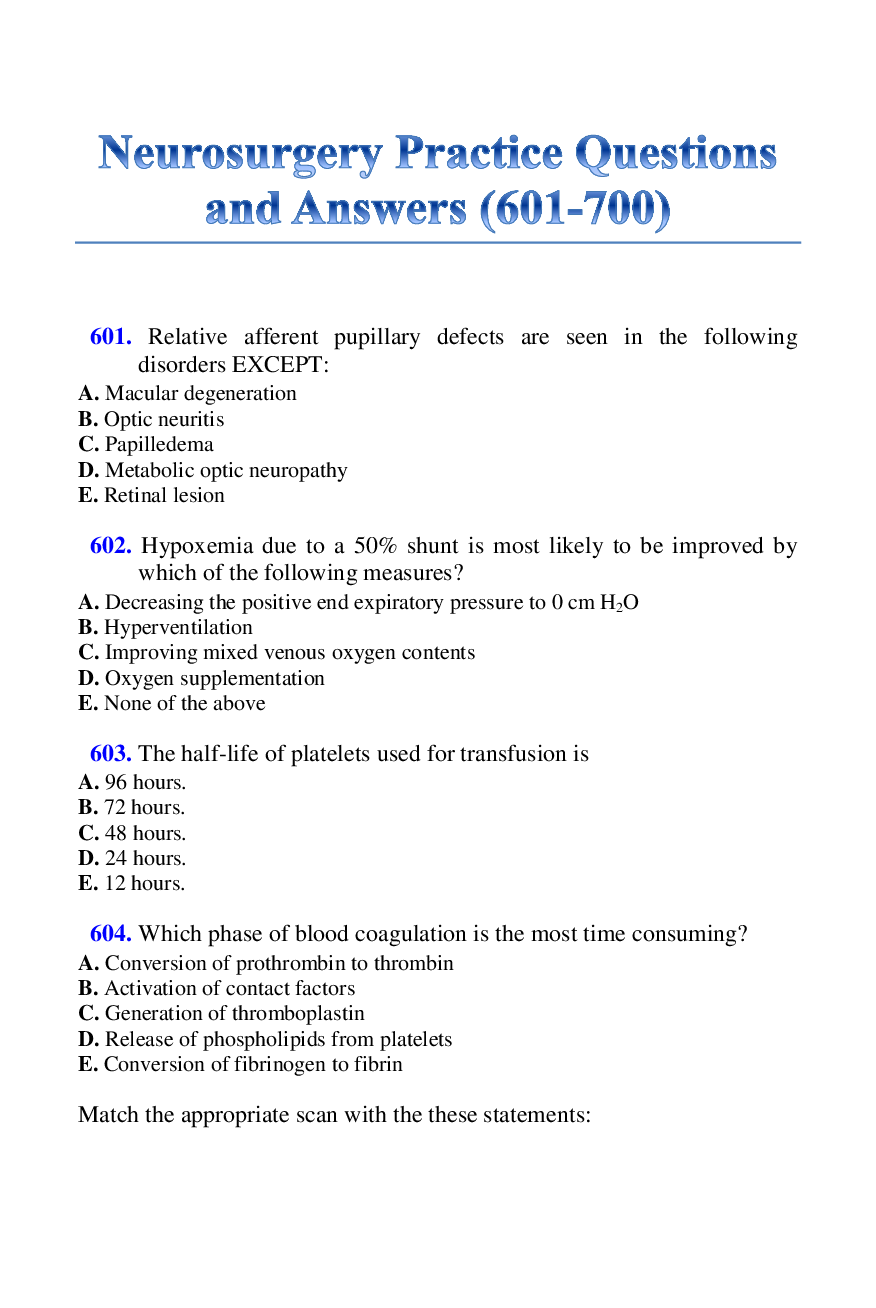
Buy this document to get the full access instantly
Instant Download Access after purchase
Add to cartInstant download
Reviews( 0 )
Document information
Connected school, study & course
About the document
Uploaded On
Apr 08, 2020
Number of pages
34
Written in
Additional information
This document has been written for:
Uploaded
Apr 08, 2020
Downloads
0
Views
52
















